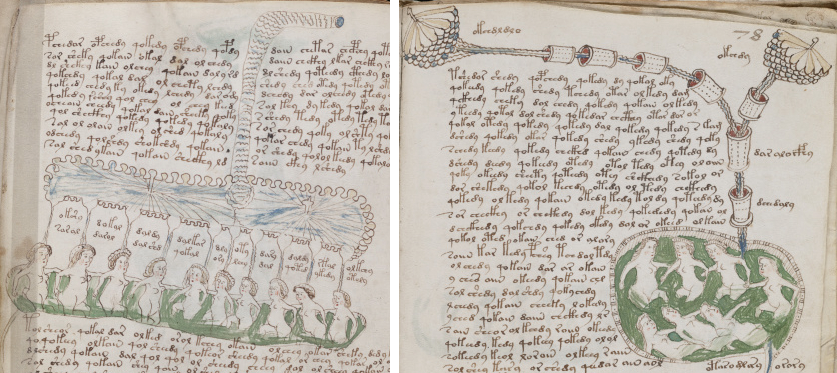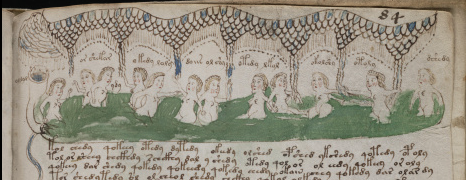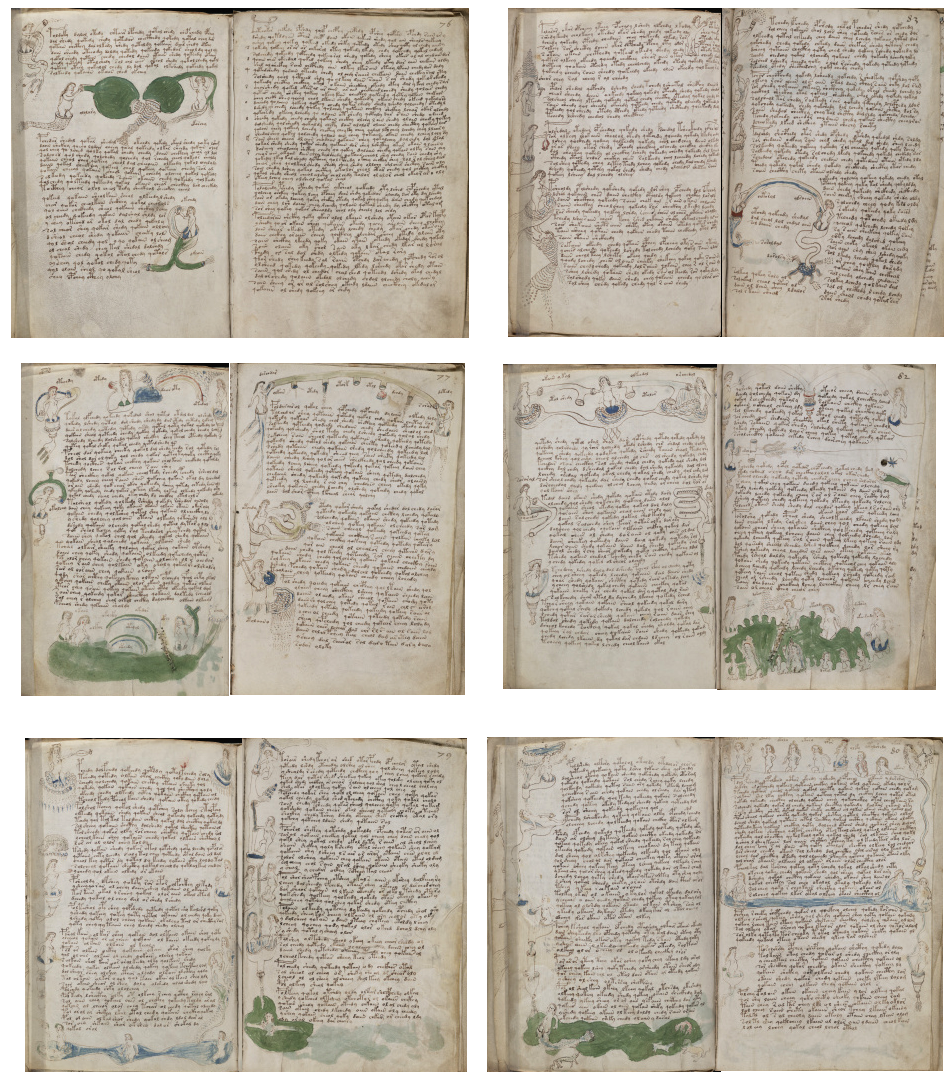http://ramblingfisherman.com/1index.php 13 September 2017
A Blast in the Past
buy neurontin online without dr approval In my previous blog, I mentioned that in 2008 I had studied Naples as a possible inspiration for the Voynich rosettes, but didn’t realize until years later that it was connected to the Baths of Puteolanis (or that this ancient spa had been suggested as a parallel to the balneological section of the Voynich manuscript).
I mostly explored the geography and topology of Naples through aerial photographs, looking for the features I felt sure were depicted in the VMS—volcanoes, steep cliffs, islands close to the mainland, jetties, canals, but because water was a prevalent theme in the VMS, I was also looking for spas that included waterfalls and grottoes and there were spas in other regions that appeared to have these features in greater abundance than Naples… or so I thought…
I have been to Naples. I stopped there briefly on my way to Greece, so I knew it was thermally active and that there were many bathing holes, but I did not know there were also caves and grottoes connected to the ancient baths, and thus missed a significant connection to the VMS.
How could I overlook such a prominent and famous feature of an ancient city? It turns out that the popular spa was destroyed by major volcanic activities in 1538. These eruptions forever changed the grottoes and thermal conduits, burying many of them under a newly formed 1,500-foot cinder-cone aptly named Monte Nuovo, and rearranging the coastline (one that may have included a fresh-water canal) so that much of it is now under water.
The Naples Baths
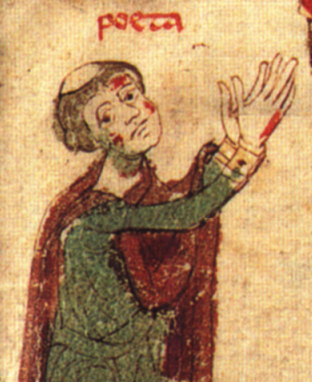 Court poet Petrus of Ebolo (c. 1196–1220 shown left) was the most significant author to document the baths prior to their destruction. He describes about three dozen baths situated between Naples and Baia (each of which had a name), and the diseases/body parts cured by each. According to Fikret Yegül, who extensively studied the history and architecture of the baths in the 1990s, only seven of the thirty-five baths appear in all of the ten illuminated copies that were known at the time the article was published, in 1996.
Court poet Petrus of Ebolo (c. 1196–1220 shown left) was the most significant author to document the baths prior to their destruction. He describes about three dozen baths situated between Naples and Baia (each of which had a name), and the diseases/body parts cured by each. According to Fikret Yegül, who extensively studied the history and architecture of the baths in the 1990s, only seven of the thirty-five baths appear in all of the ten illuminated copies that were known at the time the article was published, in 1996.
Based on extensive study and documentation of the ruins of Baia, Yegül paints a poignant picture of the bath complexes during their heyday that really caught my attention because he described aspects of the baths that no longer exist:
“The hot mineral water was brought by conduits directly into some of the chambers and filled the pools for private or public ablutions. Other units, particularly the small, domed ones, must have been intended for sweat bathing in hot, natural steam conducted into them through underground galleries and conduits… Some of the underground galleries and cavelike spaces might have been utilized even in their natural state for curative bathing and sweating…. The subterranean zone under the hillside complex is virtually riddled with caves, chambers and galleries.”
Pagan Influences
“The Apsidal Hall at Punta dell’Epitaffio appears to have been a particularly sumptuous example of the late Republican and early Imperial nymphaeum type in which aspects of a natural cave were imitated inside a vaulted architectural setting.”
The VMS has always struck me as very pagan in its presentation—almost devoid of Christian references and full of water and nymphs and an unselfconscious way of expressing nudity that was characteristic of pagan art of the Mediterranean. Yegül goes on to convey the pagan nature of the Naples-area baths:
“Originally, the apse had eight small niches instead of the three large ones seen now; these niches apparently contained fountains. Maiuri believed the complex served as a “nymphaeum” and was a part of the great rotunda… known as the “Temple of Venus”….
A nymphaeum thus conceived is not simply a fountain or source sacred to the water deities, the nymphs, but is also an architecturally integrated whole, shaped functionally and thematically around water….”
He then makes an interesting reference to Hadrian’s Villa in Tivoli (the town where the Villa d’Este water gardens are located that I described here due to architectural similarities that strongly reminded me of the VMS rosettes folio):
“… the “Fountain Court” of Nero’s Domus Transitoria, the triclinium of the Flavian Palace on the Palatine, and the various dining pavilions in Hadrian’s Villa in Tivoli (particularly the so-called Garden Stadium and the grotto pavilion at the end of the Canopus) are all creations of a kindred spirit.”
When I studied the Villa d’Este, years ago, I searched extensively for possible forerunners to the water-garden design, thinking I might find something from an earlier century that influenced the VMS, but only located bits and pieces of information, as many of the early estates were overbuilt by new gardens or other complexes. I knew that Cardinal d’Este was inspired to some extent by Hadrian’s ruins nearby, but I did not know about the connection between Hadrian’s ruins and the bathing culture in Naples or that Naples had elaborate waterworks such as those I imagined might be illustrated on the rosettes folio.
“Elaborate pipe work hints at a sophisticated play of water with jets and fountains along the length of the peripheral canal, and inside the apse and the side niches.”
Yegül goes on to describe another feature that I observed in the VMS but thought was absent from the Naples bathing spas. Apparently cascades (waterfalls) were also part of the Baia complex:
“The pool [in the Thermae of Sosandra] is connected to a grotto and an extensive network of subterranean galleries that penetrate deep into the hill to reach the source…; this source appears to have served both the Sosandra complex and Baths A, higher up the hill. Several reservoirs are located behind and above the exedra. The water must have flowed in streams and cascades into the pool and continued down to the lower terrace….
Large vaulted chambers (like subaquatic grottoes) run along the high banks of the pool enclosure connecting the pool to grottoes and tunnels carved deep into solid tufa….
A row of interconnected, vaulted cisterns behind the Ambulatio was supplied by an aqueduct of Augustan date. These and other cisterns higher up on the hill must have brought fresh water to the various bathing establishments…”
These were all the physical features I had been seeking and thought were absent from Naples (I had pictured the usual somewhat-flat open-air thermal spas that are common in this region). I knew Naples had aqueducts, but so did many places… what I didn’t know is that the spas included caves, grottoes, grotto-like galleries, vaulted chambers, and domes. As we learn from the Petrus of Eboli manuscripts, there were also tents in which to rest after taking hot thermal cures. I had prematurely put Naples aside to look elsewhere.
A Fractured Narrative?
So how might these revelations relate to the pool pages in the VMS?
It’s very easy to say the VMS has sections on “healthful bathing”. That’s exactly what it looks like, at least to me… and long before I knew about the manuscript, others had dubbed it the “balneological section”. But how much of it is actually about bathing? I think the core of this section might be quite small, consisting of only two sheets which, back-and-front, comprise only eight pages—about 5% of the manuscript.
Which folios are they and how should they be arranged? The way the VMS is currently bound, these sheets are separated by other folios.
I’m not the only one who thinks the Voynich Manuscript may have been bound out of order. Many have noticed the inconsistencies. If one were to rearrange quire 13, it’s possible to separate out the bathing images from ones that might be related but may not be the exact same subject. Here is one possible way to organize the “core” of the bathing section.
You have to imagine the following pages as two wide sheets with a margin in the middle for the fold, with front and back sides shown left and right. Note how the upper sheet has both blue and green water and the second sheet has a very consistent set of green pools with roughly similar shapes.
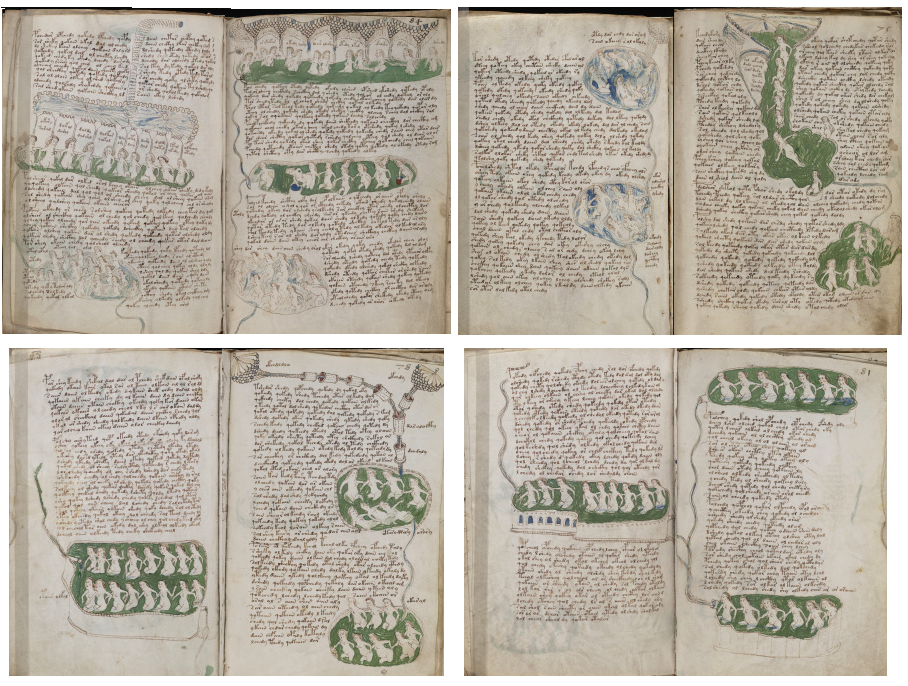
I’m not certain where the narrative starts, but I suspect it is either the second or fourth frame on the top row.
There’s also more than one way to interpret individual parts of the images. For example, in the top-left frame, is that a conduit for bringing in the water or a steam vent for warming the chamber? Or is it a conduit for venting excess steam out of the chamber?
Whether these two sheets were intended to be folded one within the other is not certain either. What if they were meant to follow one another (which would be a very unconventional way to bind them, but since very little about the VMS is conventional, one should probably consider the possibility). Whether it matters depends on how self-contained each page is intended to be. If the text on each page describes a specific bathing complex, without wrapping to the next sheet, the order might not be crucial. Wrapping to the verso side of the same sheet would not be a problem, the narrative would follow regardless of whether the manuscript were bound or unbound.
The sections that separate the above folios in the current binding also have blue and green pools, but I noticed early on that the layout is quite different. The subject matter changes and the drawings inhabit the margins in a somewhat sequential manner.
While the above illustrations strike me as pragmatic, describing physical/geological features and maybe specific bathing pools, the ones currently sandwiched between them have a much more anatomical and metaphorical feel to them and may have been intended to follow or precede the pool section.
Biological References
I’ve consolidated and shuffled the following block of pages to illustrate one possible way the sheets could be arranged separately from the pool section, with frame 2 on the top row (with the dense text that looks like it might be an index) being the first folio. It may be intended to introduce the new section (or to summarize the previous).
If there is any connection between the VMS and healthful bathing (and if the pools are meant to document a spa similar to those that existed in Naples) then the odd biological structures in the margins might represent the parts of the body that were supposedly cured by each kind of bath. This would be consistent with the way Eboli described the baths. It might be relevant to the VMS that Eboli included a list of ailments specific to females.
Koen Gheuens has presented some interesting parallels between these drawings and astrology/astronomy as it was understood in the 15th century. I find Gheuens’s ideas both interesting and plausible, given that each part of the body was believed to be ruled by a certain constellation, as evidenced by the many “zodiac man” drawings in medieval medical texts.
The Balneum Trituli had frescoes with figures pointing to the body parts that were supposedly cured by specific baths.
Imagine if the VMS author combined 1) bathing, 2) body parts cured by bathing, and 3) astrological medicine, all into one… it might come out something like the following folios. There are even sections with rainbows, which relate to both water and prisms (to this day prisms are still believed to have curative properties) and which also might represent “connections” in a metaphorical way.
Summary
If the VMS documents healthful bathing practices and cures for specific body parts, it doesn’t have to represent Pozzuoli—any grotto-like health spa with a combination of natural and manmade pools and cascades might be illustrated in the same way.
In fact Yegül points out that Charles II founded a hospital for hydrotherapy in 1298, in the village of Triepergula and I found many spa areas in eastern Europe with characteristics similar to the thermally active baths of Naples.
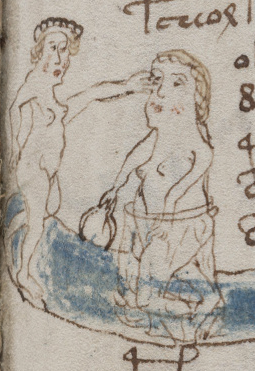 But given that the Naples bathing complexes experienced a surge of popularity after Ebolo’s manuscript was replicated, it’s not unreasonable to think they may have inspired the pool pages in the VMS. It’s also worth noting that the Baia complex was embellished with Hellenistic-themed statuary, including the Homeric blinding of Cyclops. Could the VMS eye-poking nymph be indicating a body part cured by a thermal bath, the blinding of a mythical character, a constellation related to a specific body part, or maybe all three?
But given that the Naples bathing complexes experienced a surge of popularity after Ebolo’s manuscript was replicated, it’s not unreasonable to think they may have inspired the pool pages in the VMS. It’s also worth noting that the Baia complex was embellished with Hellenistic-themed statuary, including the Homeric blinding of Cyclops. Could the VMS eye-poking nymph be indicating a body part cured by a thermal bath, the blinding of a mythical character, a constellation related to a specific body part, or maybe all three?
I’m not sure whether the VMS illustrations are based on any specific reference like the verses of Eboli. I’ve felt for a long time that the author drew on a variety of sources, combined with personal experience in some subjects such as plants, and synthesized various forms of knowledge into the unique presentation we see today. But whether the text is copied from specific sources, I don’t know—it might be—it’s hard to say when we can’t read a word of it, even now after centuries of trying.
References
You can see an e-facsimile of a mid-14th-century copy of Eboli’s Baths of Pozzuoli on the e-codices site as Cod. Bodmer 135. There are other examples, but only about half are illustrated and some of them post-date the VMS.
I am indebted to the following article by Fikret Yegül for describing topological/geological features of the Naples region before the 1538 earthquake:
Yegül, Fikret K, “The Thermo-Mineral Complex at Baiae and De Balneis Puteolanis”, The Art Bulletin, Vol. 78, No. 1 (March 1996) pp. 137–161.
J.K. Petersen
© Copyright 2017 J.K. Petersen, All Rights Reserved
Postscript: I thought I would add a single VMS page with possible parallels to some of the various copies of De Balneis.
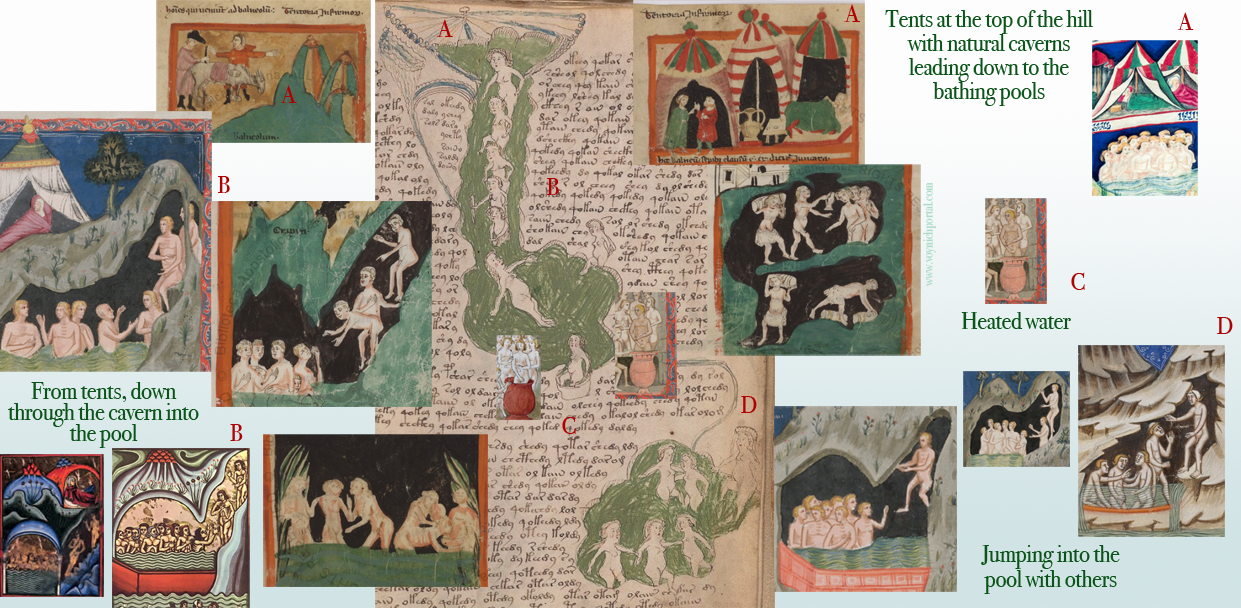
Images from a variety of De Balneis manuscripts that have actions and themes in common with the VMS nymphs-in-pools page.
There are other folios (e.g., arched pools and rainbow imagery) that might also be relevant, such as the artificial pool with architectural-style arches:
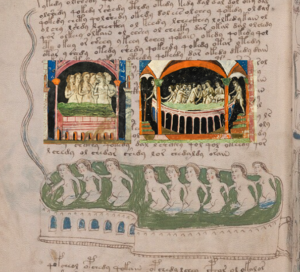
but folio 75r seems particularly relevant in terms of thematic similarities, from the tents at the top, to the people descending through a cavern to a pool below, a container of heated water, and even a figure that may be jumping or stepping into the pool at the bottom.

